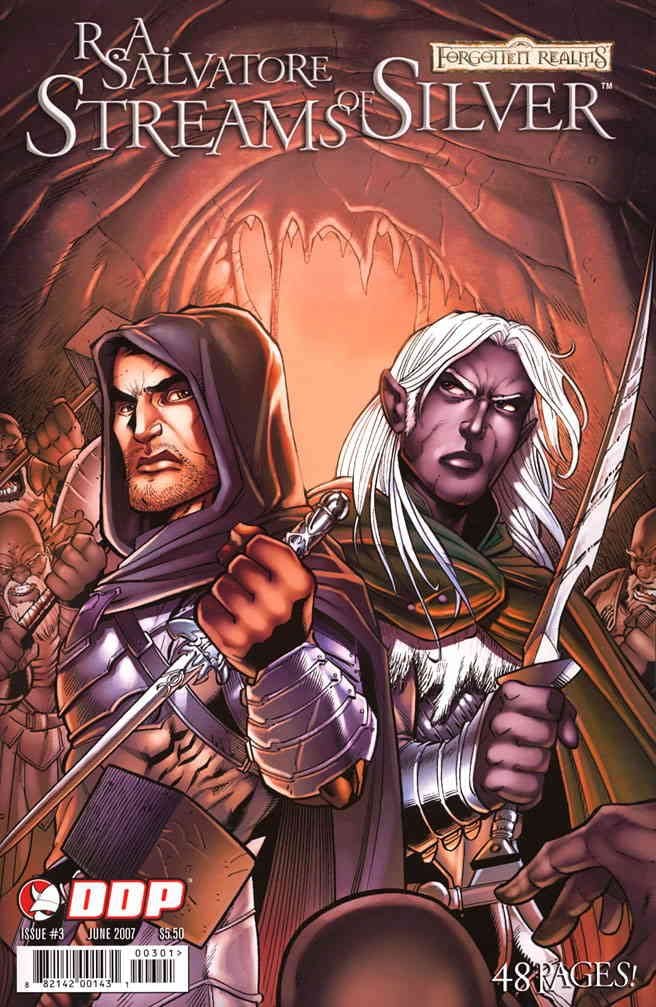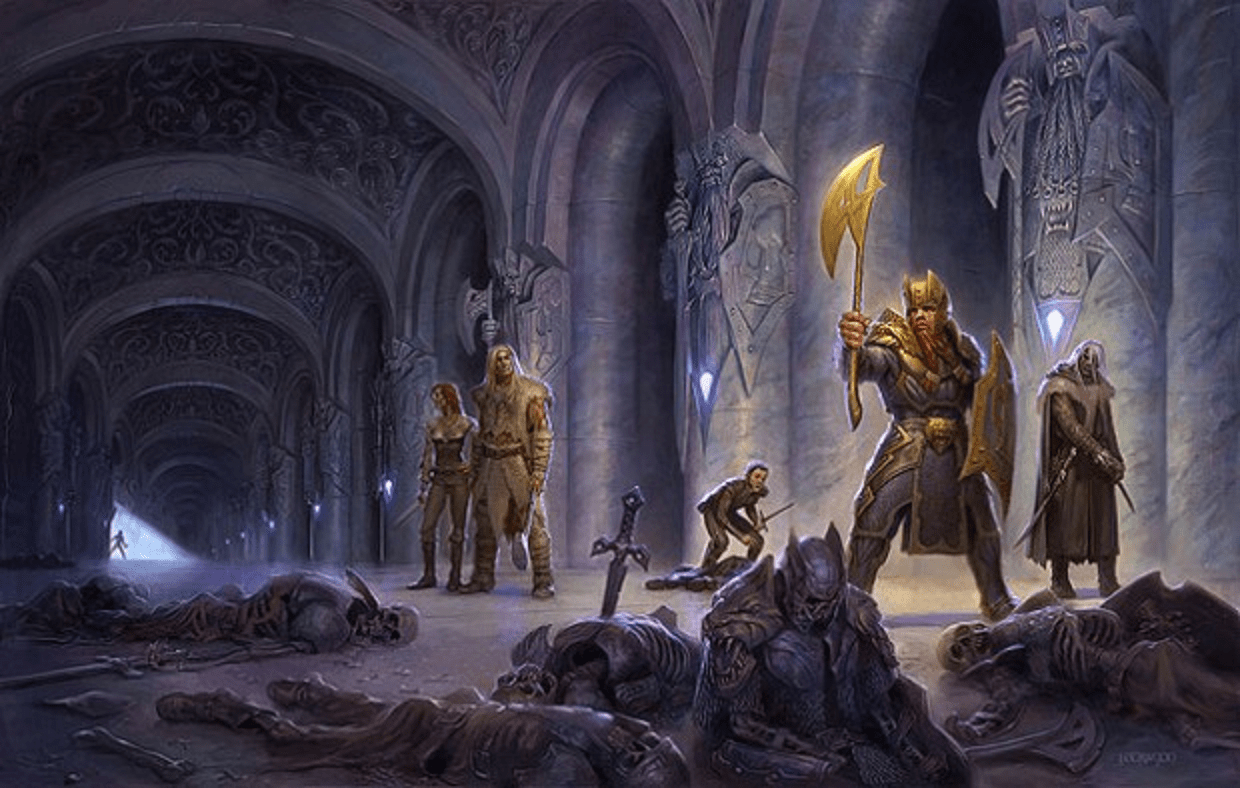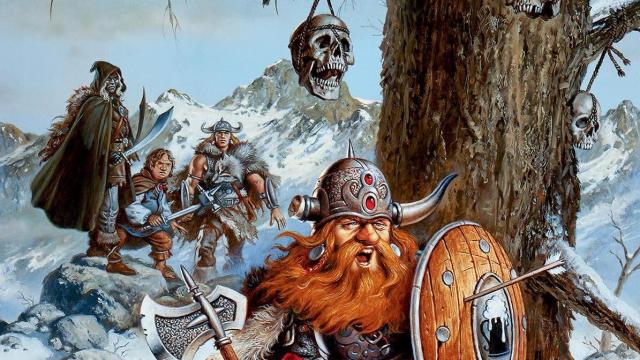The famous Drow ranger Drizzt Do’Urden returns for his second adventure in the Icewind Dale trilogy! Is it better than The Crystal Shard? Is the premise directly lifted from The Hobbit? Will Drizzt continue being the greatest badass in the Forgotten Realms? Will a female character appear for more than four pages and do literally anything? There’s only one way to know — read on!
First, the good news. Author R.A. Salvatore clearly leveled up between the publication of The Crystal Shard and Streams of Silver, because the writing of the sequel is significantly better than his initial work, as I predicted (not that predicting an author will gain skill as he continues writing throughout his career requires seeing into the future). Although it’s often overwritten and still spells out every character’s feelings and motivations instead of being evocative, it’s less egregious than its predecessor. The plotting is also somewhat improved, although that might be because it’s primarily The Hobbit sans its ring shenanigans, mish-mashed with the Mines of Moria section of Lord of the Rings.
[referenced id=”1226274″ url=”https://gizmodo.com.au/2020/06/dungeons-dragons-novels-revisiting-the-crystal-shard/” thumb=”https://gizmodo.com.au/wp-content/uploads/2020/06/27/whtbvvvw8tbc9vdbzdto-300×169.jpg” title=”Dungeons & Dragons & Novels: Revisiting The Crystal Shard” excerpt=”In the frozen tundra of novels of yore, where I read these classic fantasy books to see what treasures might still lie within”¦ and what horrors, too.”]
See if this sounds familiar: Bruenor Battlehammer (Thorin Oakenshield) was forced out of his dwarven home Mithral Hall (the Lonely Mountain) as a child when the dwarves dug too deep and let loose something evil (as the dwarves of Moria did), most notably a demonic dragon named Shimmergloom (Smaug, with a healthy portion of the Balrog). Bruenor dreams of retaking his ancestral home and brings his pals (the 12 dwarves and Bilbo) on the mission.
Where Streams of Silver differs is that somehow Bruenor and the entire planet forgot where Mithral Hall was located, despite the fact he has lived in Icewind Dale for centuries with many of the other dwarves of Clan Battlehamer who presumably once lived there as well. So much of the book is about Bruenor, Drizzt, the human barbarian Wulfgar, and the lazy/fat halfling Regis trying to find the damn thing. They go from place to place, fighting bunches of monsters along the way — including trolls, although it’s a battle instead of playing on their idiocy — accruing a bit more information in each location. This makes it feel like an actual Dungeons & Dragons campaign, which isn’t the worst thing in the world by any means, but there are more stops than the story can bear, which is rough when the premise is already a bit ludicrous.

For instance, the group first travels to the city of Luskan, where Bruenor meets with a shady rogue named Whisper (a female character who gets more lines and characterization than the dwarf’s adopted human daughter Catti-Brie does in the entirety of The Crystal Shard) to get some sort of required map which, as far as I can tell, is just a map of the Forgotten Realms. It only shows the group where some mountains are that Bruenor thinks Mithral Hall could be located; these mountains aren’t secret, so I’d think they’d also be on other maps that don’t require dealing with backstabbing thieves.
The other deviation is Artemis Entreri, a cold-blooded assassin hired to find Regis and the halfling’s stolen magic ruby. Artemis is Drizzt’s equal in fighting and opposite in morality, a mirror image of how Drizzt would have ended up if he stayed part of the universally evil Drow society instead of forsaking it. We know this because Salvatore tells us this, repeatedly. Artemis first arrives at Icewind Dale, taking Catti-Brie prisoner and dragging her along on his journey to find Regis, and is soon joined by a soldier named Jierden, a mage named Sydney, and a golem named Bok; all three work for a wizard named Dendybar, who is certain that Drizzt is carrying around the uber-powerful Crystal Shard of the first book. (He isn’t.)
[referenced id=”1362176″ url=”https://gizmodo.com.au/2020/09/magic-the-gathering-is-getting-a-whole-dungeons-dragons-set-next-year/” thumb=”https://gizmodo.com.au/wp-content/uploads/2020/09/02/zwdoiww5lae5ofdlbh4x-300×169.png” title=”Magic: The Gathering Is Getting a Whole Dungeons & Dragons Set Next Year” excerpt=”This is far from the first collaboration between the two powerhouses of Wizards of the Coast’s tabletop games — but it’s the first time D&D has really come to Magic in a major way.”]
It doesn’t make much sense for Artemis to bring Catti-Brie along, except this time Cat is a real protagonist and needs a reason to stay part of the story, with as well-rounded a personality and as much development as the other main characters. This is a massive improvement, although her character arc starts out rough. Basically, despite being a very proficient warrior herself, she’s so terrified of the assassin she can’t do anything, to the point she occasionally doesn’t even need to be tied up. Finally, she gets ahold of herself and starts doing the “sow seeds of distrust among the captors” shtick. However, when she does escape, she becomes a badass equal to the others (well, not Drizzt, only Artemis is on par with Drizzt). She manages to trap the golem under a rock pile during her flight, catching up with the others right before they enter Mithral Hall for the final act.
That final act happens to be quite good! In addition to the dragon, the Hall is full of traps, countless evil grey dwarves called Duergar, and hell hounds. When Artemis shows up, he and Drizzt fall into a trap, separating the party from their best fighter. By the end, Bruenor, Wulfgar, and Catti-Brie are trying to survive a massive Duergar attack and escape before the hell hounds arrive when Sydney and the golem show up and attack, followed by Shimmergloom, and it’s all genuinely exciting.
The ending is perfectly Dungeons & Dragons-esque, with the desperate Bruenor leaping off a gorge onto the dragon’s back while carrying a flaming cloak and a keg of oil, which explodes and kills them both. Alas, by the book’s end, Artemis has taken Regis, the ruby, and Drizzt’s magical panther-summoning statuette of Guenhwyvar, which spurs Drizzt and Wulfgar to hunt down the assassin in the third book of the trilogy, The Halfling’s Gem. Catti-Brie stays behind, but only because she plans on organising an army to retake Mithral Hall for good, which is pretty rad.

There’s still a lot of problems in Streams of Silver; characters completely change their beliefs and attitudes at the drop of a hat (e.g., Wulfgar hates and distrusts all magic until he suddenly decides to stop), and the characters can either perfectly read each other’s minds or be utterly baffled by their friend’s behaviour. Occasionally someone (mostly Bruenor) has to make some very obviously stupid decisions to give the gang things to do and fight. Probably the worst part is an extremely cringe-worthy scene where Alustriel, the leader of the supposedly uber-inclusive city of Silverymoon, denies Drizzt entry because of unspecified “politics” but gives him the consolation prize of telling him the people of the Forgotten Realms will accept him at some point in the future. But it also might be when Regis uses his hypnotising gem to steal a prostitute from Wulfgar; nothing comes of it, but it is as gross as it is weird.
Still, the fact that the book has a solid female protagonist and antagonist (that would be Sydney) is a vast and much-needed improvement over The Crystal Shard. They don’t make up for all of the book’s problems, so Streams of Silver rolls a six on a 1d20… but it has a bonus of +1 because the book begins with a Drizzt journal entry on the importance of fantasy which contains as nice a mission statement for Dungeons & Dragons as I’ve ever read:
“We make the dragons as we make the gods, because we need them, because, somewhere deep in our hearts, we recognise a world without them is a world not worth living in.”

Assorted Musings:
- Drizzt’s other two journal entries include some heavy-handed thoughts on nostalgia and the D&D equivalent of gun control, so don’t get too excited.
- The group encounters a group of barbarians called the Sky Ponies, which is not a particularly intimidating barbarian tribe name. Now the Sky Bronies, that’s a group to steer clear of.
- Bok is a flesh golem, which is basically like Frankenstein’s monster. However, other golems — stone golems, clay golems, and iron golems — are all made up entirely of their named element. This means I can’t stop thinking about flesh golems as a pure ambulatory sack of skin, and now you have to think about it too.
- At one point, Wulfgar is hit by lightning. He lives, but the horse underneath him explodes, pointedly demonstrating the importance of making your saving throws.
- Oh! I forgot that the dwarves of Moria awakened the Balrog by digging too deep specifically for Mithril. Given that Bruenor’s home is called Mithral Hall, I expect you can put two and two together.
- …and to get into Mithral Hall, you have to find a secret door and speak the password which Bruenor has forgotten, exactly like Moria. However, these dwarves built in a failsafe where you can open the door just by tapping on it with a magic weapon, which feels like the D&D equivalent of leaving a key on the front porch under a potted plant.
- I can’t believe I forgot to give Darkwalker on Moonshae and Spellfire their ratings! Darkwalker rolls a five, and while the terrible Spellfire gets a critical miss with a natural one.
- Next up: Vampire of the Mists, the first novel in the D&D’s horror setting Ravenloft! Which, if I were smart, I should have done a week or two ago!
